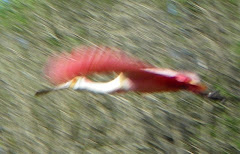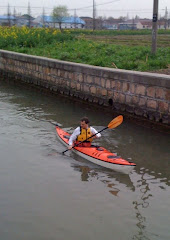Iconic chalk cliffs
The Seven Sisters Country Park,
in the south of England, features precipitous chalk cliffs, where the sea has cut
into the undulating dry valleys and ridges of the south downs. To the east of
the seven sisters, the cliffs peak at Beachy Head. At 530 feet high, this is
the tallest chalk cliff in England. Diminutive by comparison, a red and white
painted lighthouse stands below on a wave-cut ledge.
 |
| Beachy Head with lighthouse |
Beachy Head Lighthouse, and Belle Tout
This elegantly tapered granite tower was the last traditional offshore lighthouse to be built by Trinity House in this tower style. Starting operation in 1902, it replaced the earlier, 1834, clifftop Belle Tout lighthouse. Belle Tout was frequently obscured by sea mist, and, inconveniently, was out of sight of ships passing close to the rocks below. The newer lighthouse was better placed.
Belle Tout, however, is still there, currently operated as bed-and-breakfast accommodation. In 1999, when threatened by cliff erosion, the 850-ton structure was moved inland 56 feet. The cliff erodes with a big collapse periodically, at an average of about two feet per year. Sooner or later the lighthouse will need to move again, or it will end up at the bottom of the cliff.
Kayaking beneath the cliffs
When I lived in southeast England, I rated Beachy Head and the Seven Sisters as one of the most scenically attractive sections of the coast within easy reach by kayak. Launching onto the River Cuckmere at Exceat Bridge, to the west, a round trip to Eastbourne beneath these amazing chalk cliffs measured about fifteen miles.
In those days, three keepers manned the lighthouse which was powered by paraffin (Kerosene), until a supply of electricity reached the lighthouse in 1975. I moved away from southeast England before 1983, when the lighthouse became fully automatic, and the keepers were no longer needed.
 |
| Beachy Head lighthouse |
Birling Gap
At Birling Gap, between the Seven Sisters cliffs and Beachy Head, a hamlet with road access perches in a dry valley at the cliff-edge. Many of the original buildings have already been taken by cliff falls.
There was usually a temporary flight of steps of some kind from the cliff top to access the beach. Since the sea frequently damaged or washed away the steps, access was never guaranteed. The carry down, and back up was often awkward to negotiate with kayaks, especially when replacement steps took tight turns. We used this launch place to catch the tide east past the Beachy Head lighthouse, with its ledges and overfalls, toward the Royal Sovereign shoals offshore Eastbourne.
The Royal Sovereign Shoals.
The Royal Sovereign shoals are littered with wrecks. From 1875 onward, a lightship was moored there to alert ships of the dangers. The most recent lightship to serve there resembled the Varne lightship, shown. The Varne marked a point roughly midway between England and France, a comforting confirmation of our progress when I first crossed the English Channel with friends in 1974.
 |
| Varne lightship, Mid-English Channel |
The Royal Sovereign lightship was replaced by a lighthouse in 1970. As a teenager at that time, I was fascinated by the plans for how that lighthouse would be constructed, and how it would be positioned on these always underwater shoals. It would look quite different from a traditional tower lighthouse.
 |
| 1967 Admiralty chart shows Beachy Head and Royal Sovereign shoals |
The Royal Sovereign Lighthouse.
The structure was built in two parts, on the beach at Newhaven. The hollow base, with the column attached, was towed out to the shoal. The base, once flooded, sank onto a leveled area of shoal.
The second part of the lighthouse, a rectangular cabin section with a helicopter landing pad, and light tower, was towed out later. At high tide, this structure was held above the base until the falling tide dropped it into position on the column. Finally, the telescoping inner section of the column was jacked up by 43 feet and cemented into its elevated position.
The lightship was towed away when the lighthouse began service in September 1971. The lighthouse, provisioned by helicopter, was manned by three keepers. The whole construction procedure was filmed and can be seen on YouTube (22 minutes)
 |
| Royal Sovereign Lighthouse |
A closer look
This unusual lighthouse stood tantalizingly within reach by kayak, just 6 miles offshore from Eastbourne. In March 1976, I left from Eastbourne to see it up close, timing my crossing to arrive at slack tide. Eastbourne offered an easier solo beach launch than Birling Gap with its steps.
The tides may have run as forecast that day, but the weather certainly did not. The wind picked up from the southwest, kicking up a sea. My spray deck leaked, and with so much water washing over, my cockpit began to fill. I carried a sponge, but when I unsealed my spray deck, waves flooded the cockpit faster than I could bail. I gave up and pushed on.
My kayak had a bulkhead immediately behind the seat, and another beyond my feet, so although water could not flood the whole kayak, it drained forward. The deeper the water grew in the cockpit, the more it weighed down the bow, and the more forcefully the kayak weather cocked away from where I wanted to go. It was a tough paddle back.
A lesson learned
That experience got me thinking not only about a better spray deck, but also about bilge pumps. Preparing to circumnavigate Iceland by Kayak the next year, 1977, I deck-mounted a Henderson Chimp pump on my new kayak.
 |
| Deck-mounted bilge pump with red and black handle |
This kind of pump made it possible to empty a cockpit without removing the spray deck. Easy enough to operate when rafted to another kayak, it was challenging to use when balancing in rough seas, solo. I next experimented with foot-operated pumps which let me continue paddling while pumping.
 |
| Kayaks approach lighthouse |
Visiting the keepers on the platform
Next month, I paddled out to the Royal Sovereign lighthouse with friends. With visibility limited to four miles, I called the coastguards beforehand to inform them of our plan. Bearing gifts of newspapers and fresh milk, we paddled into the fog on a compass bearing. At the lighthouse, we climbed out onto the ladder on the column, tied our kayaks, and scaled the ladder to knock on the door. One of the keepers welcomed us and treated us to a tour of the lighthouse followed by coffee.
By the time we clambered back down the ladder, the tide had turned, carrying our kayaks out of sight behind the pillar. Anxiously, we hauled on the lines, relieved to find the kayaks still firmly tethered.
When crossing from Eastbourne, the tide offered little assistance. But on the 18-mile round-trip from Birling Gap it gave us a helpful boost, especially past Beachy Head. The extra miles compared to a round trip from Eastbourne were more than compensated for by the assistance of a spring tide. We timed our launch from Birling Gap, on the flood tide, to round the lighthouse at high water slack and return with the ebb. Birling Gap became my favorite launching place.
Where is the lighthouse now?
The Royal Sovereign lighthouse was a great target for a fun day trip by kayak, but times change. The light was automated in 1994, and from 2006 onward everything was controlled from shore. Full-time keepers were no longer needed, and the lighthouse remained unoccupied except, occasionally, for maintenance.
The concrete Royal Sovereign lighthouse, state-of-the-art when built, deteriorated more rapidly than the granite Beachy Head light tower. It was only designed to last for 60 years. Royal Sovereign was taken out of service on March 21, 2022, and scheduled for removal.
Removal is expected to take three summers, while buoys, north, south, east, and west cardinals mark the shoals. Will there be another lighthouse there? Unlikely. Since ships carry far better navigation systems than in the past, a lighthouse here is considered redundant.
The first stage of deconstruction began in October 2023, with the removal of the rectangular top section. For now, only the column, on its base, remains. Has anyone been tempted to paddle out to see it before the column is removed?
If you are interested in learning more about the lighthouse,
Bexhill Maritime
offers a wonderful description.


































2 comments:
Great article; I will look into deck mounted bilge pumps.
Thanks for the glimpse of history, Nigel! Your passing comment about crossing the channel is another story of its own I’d like to hear.
Post a Comment